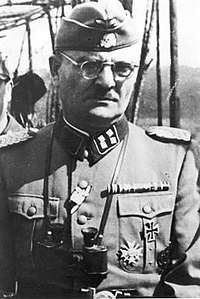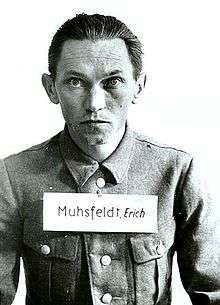Aktion Erntefest
| Aktion Erntefest | |
|---|---|
.jpg) One of many mass graves of the Nazi German Operation Harvest Festival | |
| Location | Majdanek concentration camp, occupied Poland |
| Coordinates | 51°15′11″N 22°34′18″E / 51.25304°N 22.57155°ECoordinates: 51°15′11″N 22°34′18″E / 51.25304°N 22.57155°E |
| Date | November 3, 1943 |
| Target | Primarily Jews |
Attack type | Shooting |
| Weapons | Rifles, automatic weapons |
| Deaths | 43,000 |
| Perpetrators | SS, Order police, Trawniki men |
The Aktion Erntefest (German: Operation Harvest Festival) was a World War II mass shooting action carried out by the SS, the Order police, and the Ukrainian Sonderdienst formations in the General Government territory of occupied Poland. The operation aimed at extermination of Jews pressed into forced-labour at the camps of the Lublin reservation including Majdanek concentration camp and all its subcamps. It was closely linked with the liquidation of the ghetto in Lublin. Aktion Erntefest took place on November 3 and 4, 1943.[1] On the orders of Christian Wirth and Jakob Sporrenberg, approximately 42,000–43,000 Polish Jews were killed simultaneously. Virtually the entire Jewish workforce was eliminated, thus concluding Operation Reinhard.[2][3]
Operation Harvest Festival was the single largest German massacre of Jews in the entire war. It surpassed the notorious massacre of more than 33,000 Jews at Babi Yar outside Kiev by 10,000 victims. It was exceeded only by the 1941 Odessa massacre of more than 50,000 Jews in October 1941, committed by Romanian troops.[4]
Background
The timing of the operation was apparently in response to several efforts by surviving Jews to resist the Nazis (for example, the uprisings at the Sobibor and Treblinka extermination camps, and armed resistance in the Warsaw, Białystok, and Vilna ghettos). The SS feared additional Jewish-led revolts in the General Government,[5] ahead of the Soviet counter-offensive. To prevent further resistance the SS decided to kill most of the remaining Jews who were employed in forced-labor projects of the Ostindustrie (Osti) enterprise owned by the SS, while imprisoned at the Trawniki, Poniatowa, and Majdanek concentration camps with subcamps in Budzyn, Kraśnik, Puławy, Lipowa and others.[6] The inmates were ordered to dig "anti-tank trenches" and were therefore unaware of their true purpose as mass graves.[3]

The Germans encountered resistance when they tried to carry out the final liquidation of the Warsaw and Bialystok ghettos, and revolts broke out in the death camps of Treblinka and Sobibór when the work Jews there realized that the camps were about to be closed. Himmler could not expect to liquidate the Lublin work camps gradually, or one by one, without encountering further Jewish resistance born of desperation. The inmates of the Lublin labor camps would therefore have to be killed in a single massive operation that would catch them by surprise. Such was the genesis of Erntefest.[7]
The Orpo Reserve Police Battalion 101 tasked with performing Aktion Erntefest had long-term experience in the area prior to 1943. It was involved with the liquidation of the ghettos in the Lublin district of the General Government from which the same targets originated. Members of the battalion conducted roundups and deportations to Treblinka and Majdanek death camps as part of Aktion Reinhard, but on several occasions they also committed mass murders, including the Józefów Ghetto massacre with 1,500 victims and the Miedzyrzec Ghetto massacre of late 1942.[8] The men of the Reserve Police Battalion 101 worked hand-in-hand with the Trawniki men from Ukraine already since August 1942 committing war crimes in a string of other locations in Poland including Łomazy, Radzyń, Łuków, Końskowola (massacre at the hospital), Komarówka, Tomaszów, Serokomla, Talczyn and Kock among others.[8][9]
The killings
"Erntefest" was the largest single-day, single-camp massacre of the Holocaust under direct German occupation,[10] totaling 43,000 in three nearby locations.[2] It began at dawn on 3 November 1943. The main camp as well as the Trawniki and Poniatowa subcamps of the Majdanek extermination camp were surrounded by SS and the Reserve Police Battalion 101 (a unit of the German Order Police from Hamburg) augmented by a squad of Hiwis called "Trawniki men" from Ukraine. The Jews were taken out of the camps in groups and shot layer upon layer inside the pits dug specifically for this purpose. The burial site resembled a "solid mass of women's and men's bodies heaped together... with legs and arms interlinked."[11]

At Majdanek, Jews were first separated from the other prisoners. They were then taken in groups to long and deep trenches and shot one-by-one under the leadership of Erich Muhsfeldt (described by Anton Thernes as a "pathological killer").[12] At the main camp, 18,400 Jews were killed on 3 November 1943.[11] Jews from those other labor camps in the Lublin area were also taken to Majdanek and shot simultaneously. Music was played through loudspeakers at both Majdanek and Trawniki to drown out the noise of the mass shooting. The killing operation was completed in a single day at Majdanek and Trawniki. At Poniatowa the shootings took two days, because in one of the barracks Jews staged a revolt. To stamp it out the SS set it on fire and the killings went on as planned.[13]
At the conclusion of the Erntefest massacres, the district of Lublin was for all practical purposes judenfrei. The murderous participation of Reserve Police Battalion 101 in the Final Solution came to an end... For a battalion of less than 500 men, the ultimate body count was at least 83,000 Jews. — Christopher R. Browning, Ordinary Men [14]
Notes
- ↑ Browning 1998, p. 138.
- 1 2 Gruner, Wolf (2006). Jewish Forced Labor Under the Nazis: Economic Needs and Racial Aims, 1938-1944. Cambridge University Press. p. 271. ISBN 0521838754.
On November 3 and 4, 1943, the SS launched one of the largest murder operations ever against Jewish forced laborers, the notorious "Aktion Erntefest" (Operation Harvest Festival) – 42,000 to 43,000 Jews were killed.[p.271]
- 1 2 "Aktion Erntefest". Interrogation of Sporrenberg – National Archives Kew WO 208/4673. Holocaust Research Project.org. 2007. Retrieved 2013-04-17.
- ↑ Browning 1998, p. 135, Reserve Police Battalion 101 participation in the Final Solution culminated in the great "harvest festival" (Erntefest) massacre, the single largest German killing operation against Jews in the entire war. With a victim total of 42,000 Jews in the Lublin district, Erntefest surpassed even the notorious Babi Yar Massacre of more than 33,000 Jews.[p.135]
- ↑ Holocaust Encyclopedia 2007.
- ↑ ARC (2004). "Erntefest". Occupation of the East. ARC. Retrieved 2013-04-26.
- ↑ Browning 1998, p. 137.
- 1 2 Robertson 2013, section 12 & 14.
- ↑ Browning 1998, pp. 135–142.
- ↑ USHMM (May 11, 2012). "Soviet forces liberate Majdanek". Lublin/Majdanek: Chronology. United States Holocaust Memorial Museum, Washington, DC. Retrieved 2013-04-13.
- 1 2 Lawrence, Geoffrey; et al., eds. (1946), "Session 62: February 19, 1946", The Trial of German Major War Criminals: Sitting at Nuremberg, Germany, 7, London: HM Stationery Office, p. 111, retrieved 2013-04-26 .
- ↑ Narration (2013). "Anton Thernes answers questions at the Majdanek Trials. Historical film footage". Majdanek concentration camp. Part 2 of 5. Google+: real life sharing (from Official archives of the Republic of Poland). Retrieved 2013-04-22.
- ↑ Jakub Chmielewski (2013). "Obóz pracy w Poniatowej". Obozy pracy w dystrykcie lubelskim (Labor camps in the Lublin District). Leksykon Lublin. Retrieved 2013-04-26.
- ↑ Browning 1998, pp. 141–142.
References
- Browning, Christopher R. (1998) [1992]. "Arrival in Poland" (PDF). Ordinary Men: Reserve Police Battalion 101 and the Final Solution in Poland. Penguin Books. Archived from the original (PDF file, direct download 7.91 MB complete) on October 19, 2013. Retrieved May 7, 2013.
Also: PDF cache archived by WebCite.
- Holocaust Encyclopedia (2007), Aktion "Erntefest" (permission granted to be reused, in whole or in part, on Wikipedia; OTRS ticket no. 2007071910012533). Copyright © United States Holocaust Memorial Museum, released under the GFDL. Retrieved 15 August 2007. The Museum can offer no guarantee that the information is correct in each circumstance.
- Robertson, Struan (2013). "The genocidal missions of Reserve Police Battalion 101 in the General Government (Poland) 1942-1943". Hamburg Police Battalions during the Second World War. Regionalen Rechenzentrum der Universität Hamburg. Archived from the original on February 22, 2008. Retrieved 5 December 2014.
- Rosenberg, Jennifer. "Aktion Erntefest". 20th Century History. About.com Education. Archived from the original on 2016-12-27 – via Internet Archive.
- Arad, Yitzhak: Belzec, Sobibor, Treblinka: The Operation Reinhard Death Camps. Indiana University Press, Indianapolis 1987. ISBN 0585278172
- Gilbert, Martin: The Holocaust: A History of the Jews of Europe During the Second World War. Holt, Rinehart and Winston, New York 1985.
- Marszałek, Józef: Majdanek: The Concentration Camp in Lublin. Interpress, Warsaw 1986. ISBN 8322321384
- Lenarczyk W. (ed) and Libionka, D., Erntefest – Zapomniany epizod Zagłady: 3-4 listopada 1943, Państwowe Muzeum na Majdanku, Lublin, 2009, ISBN 978-83-925187-5-4.
- This article may incorporate text from the United States Holocaust Memorial Museum article, released under the GFDL.